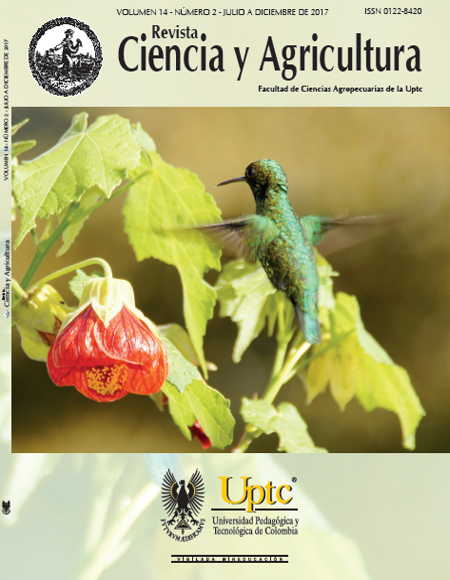Comportamiento productivo e incidencia de diarrea en cerdos posdestete suplementados con polvo mixto de hojas de plantas con propiedades nutracéuticas
DOI:
https://doi.org/10.19053/01228420.v14.n2.2017.7145Keywords:
cerdos, nutracéutico, porcicultura, productividad porcina, suplementación alimentariaAbstract
Para evaluar el efecto de la suplementación dietética con polvo mixto de hojas de plantas con propiedades nutracéuticas (40 % A. occidentale, 20 % M. oleifera, 20 % M. citrifolia y 20 % P. guajava) en el comportamiento productivo y en la incidencia de diarrea en cerdos posdestete, se utilizaron 150 cerdos (Yorkland x Yorkshire) de 33 días de edad, con peso vivo promedio de 7.74 kg±0.71. Se aplicó un diseño completamente aleatorizado con seis repeticiones por tratamiento y cinco cerdos por repetición, durante 42 días. Los tratamientos fueron, T0: Dieta Basal (DB) sin Antibiótico Promotor de Crecimiento (APC); T1: DB+APC (Labionor 5 mL/kg de pienso); T2: DB+0.5 % de polvo mixto; T3: DB+1.0 % polvo mixto, y T4: DB+1.5 % de polvo mixto. La viabilidad mejoró (P<0.05) con la suplementación dietética del polvo mixto y el APC, comparada con el T0; los T3 y T4 incrementaron (P<0.05) el peso vivo final con relación al T0 y al T1, y el T4 mostró (P<0.05) la mejor ganancia media diaria y conversión alimenticia, con diferencias significativas (P<0.05) con el T0 y el T1. Las suplementaciones del polvo mixto y del APC disminuyeron (P<0.05) la incidencia de la diarrea en los cerdos posdestete. Se recomienda la suplementación dietética de 1.0 % del polvo mixto de hojas de plantas con propiedades nutracéuticas como alternativa a los APC, para incrementar los indicadores productivos y disminuir la incidencia de diarrea en los cerdos posdestete.
Downloads
References
Canibe N. Sistemas de alimentación y aditivos en piensos de iniciación. En: XXIII Curso de Especialización FEDNA, Madrid. 2007. Disponible en: http://www.acorex.es/es/pienso/Alimentaciondelechones.pdf.
Pluske JR., Jae-Cheol K., Hansen CF., Mullan BP., Payne HG., Hampson DJ., et al. Piglet growth before and after weaning in relation to a qualitative estimate of solid (creep) feed intake during lactation: A pilot study. Arch Anim Nutr. 2007; 61(6): 469-80. DOI: http://doi.org/10.1080/17450390701664249. DOI: https://doi.org/10.1080/17450390701664249
Fuller R. Probiotics in man and animals. J Appl Bacteriol. 1989; 66(5): 365-78. DOI: http://doi.org/10.1111/j.1365-2672.1989.tb05105.x. DOI: https://doi.org/10.1111/j.1365-2672.1989.tb05105.x
Jensen BB. The impact of feed additives on the microbial ecology of the gut in young pigs. J Anim Feed Sci. 1998; 7: 45-64. DOI: http://doi.org/10.22358/jafs/69955/1998. DOI: https://doi.org/10.22358/jafs/69955/1998
King RH-, Pluske JR. Nutritional management of the pig in preparation of weaning. En: Weaning the Pig-Concepts and Consequences. Holanda; 2003. pp. 37-51. DOI: https://doi.org/10.3920/978-90-8686-513-0
Martin W., Verstegen A., Williams BA. Alternatives to the use of antibiotics as growth promoters in monogastric animals. Anim Biotechnol. 2002; 13(1): 113-127. DOI: http://doi.org/10.1081/ABIO-120005774. DOI: https://doi.org/10.1081/ABIO-120005774
Martínez Y., Martínez O., Liu G., Ren W., Rodríguez R., Fonseca Y., et al. Effect of dietary supplementation with Anacardium occidentale on growth performance and immune and visceral organ weights in replacement laying pullets. J Food Agric Environ. 2013; 13: 1352-1357.
Bontempo P., Doto A., Miceli M., Mita L., Benedetti R. Psidium guajava L. anti-neoplastic effects: induction of apoptosis and cell differentiation. Cell Prolif. 2012; 45(1): 22-31. DOI: http://doi.org/10.1111/j.1365-2184.2011.00797.x. DOI: https://doi.org/10.1111/j.1365-2184.2011.00797.x
Foidl N., Mayorga L., Vázquez W. Utilización del marango (Moringa oleifera) como forraje fresco para ganado. FAO Anim Prod Health Pap. 1999; 341-50.
Price ML. The Moringa tree. Educational Concerns for Hunger Organization (ECHO). 1985. Disponible en: http://www.echotech.org/technical/technotes/moringabiomasa.pdf.
Mc Clatchey W. From Polynesian healers to health food stores: Changing perspectives of Morinda citrifolia (Rubiaceae). Integr Cancer Ther. 2002; 1(2): 110-20. DOI: http://doi.org/10.1177/1534735402001002002. DOI: https://doi.org/10.1177/1534735402001002002
Wang MY., West BJ., Jensen CJ., Nowicki D., Su C., Palu AK. Morinda citrifolia (Noni): a literature review and recent advances in Noni research. Acta Pharmacol Sin. 2002; 23(1): 1127-1141.
Cromwell GL. Why and how antibiotics are used in swine production. Anim Biotechnol. 2002; 13(1): 7-27. DOI: http://doi.org/10.1081/ABIO-120005767. DOI: https://doi.org/10.1081/ABIO-120005767
Martínez Y., Martínez O., Olmos E., Siza S., Betancur C. Nutraceutical effect of Anacardium occidentale (AO) in diets of replacement laying pullets. JMVZ Córdoba. 2012; 17(3): 3125-3132. DOI: https://doi.org/10.21897/rmvz.211
Rodríguez R. Estudio in vitro del valor nutritivo y de los efectos antinutricionales de cuatro leguminosas arbóreas tropicales con potencialidades como suplementos del Pennisetum purpureum. Tesis de Doctorado. España: Universidad de Zaragoza; 2010.
Yin YL., Zhong HY., Huang RL., Chen CM., Li TJ., Pai YF. Nutritive value of feedstuffs and diets for pigs: I. Chemical composition, apparent ileal and fecal digestibility. Anim Feed Sci Technol. 1993; 44(1): 1-27. DOI: http://doi.org/10.1016/0377-8401(93)90034-H. DOI: https://doi.org/10.1016/0377-8401(93)90034-H
NRC. Nutritional Requirements for Swine. National Academy Press. Washington, DC: National Research Council, Nutrient Requirements of Swine; 1998.
IIP. Manual de procedimientos técnicos para la crianza porcina. La Habana, Cuba; 2015. 124 p.
Hampson DJ. Alterations in piglet small intestinal structure at weaning. Res Vet Sci. 1986; 40(1): 32-40. DOI: https://doi.org/10.1016/S0034-5288(18)30482-X
Kong XF., Wu GY., Liao YP., Hou ZP., Liu HJ., Yin FG., et al. Effects of Chinese herbal ultra-fine powder as a dietary additive on growth performance, serum metabolites and intestinal health in early-weaned piglets. Livest Sci. 2007; 108(1): 272-275. DOI: http://doi.org/10.1016/j.livsci.2007.01.079. DOI: https://doi.org/10.1016/j.livsci.2007.01.079
Ayala L., Silvana N., Zocarrato I., Gómez S. Use of vulgar oregano (Origanum vulgare) as phytobiotic in fatting rabbits. Cuban J Agric Sci. 2011; 45(2): 159-161.
Ding YY., Zhang CH., He XL., Huang L., Yin ZJ.. Growth performance responses and indicators of gastrointestinal health in early weaned pigs fed chinese herbal medicine additives-supplemented diets. J Anim Vet Adv. 2011; 10(12): 1580-1587. DOI: http://doi.org/10.3923/javaa.2011.1580.1587. DOI: https://doi.org/10.3923/javaa.2011.1580.1587
Okuda T. Systematics and health effects of chemically distinct tannins in medicinal plants. Phytochemistry. 2005; 66(17): 2012-2031. DOI: http://doi.org/10.1016/j.phytochem.2005.04.023. DOI: https://doi.org/10.1016/j.phytochem.2005.04.023
Castillo A. Evaluación de la actividad antimicrobiana de los extractos de Mirabilis jalapa L. y Morinda citrifolia L. Tesis de Maestría. Cuba: Universidad de Granma; 2011. DOI: https://doi.org/10.4067/S0718-07642011000500004
Ghasemi R., Zarei M., Torki M. Adding medicinal herbs including garlic (Allium sativum) and thyme (Thymus vulgaris) to diet of laying hens and evaluating productive performance and egg quality characteristics. Am J Anim Vet Sci. 2010; 5(2): 151-154. DOI: http://doi.org/10.3844/aja-vsp.2010.151.154. DOI: https://doi.org/10.3844/ajavsp.2010.151.154
Kong XF., Wu GY., Yin YL., Liu HJ., Yin FG., Li TJ., et al. Dietary supplementation with Chinese herbal ultra-fine 3 powder enhances cellular and humoral immunity in early weaned piglets. Livest Sci. 2007; 108 (1): 94-98. DOI: http://doi.org/10.1016/j.livsci.2007.01.002. DOI: https://doi.org/10.1016/j.livsci.2007.01.002
Kamel C. Natural plant extracts: classical remedies bring modern animal production solutions. Feed manufacturing in the Mediterranean region. Improving safety: from feed to food. En: Brufau J. Zaragoza: CIHEAM-IAMZ; 2001. p. 31-38.
Balunas MJ., Kinghorn AD. Drug discovery from medicinal plants. Life Sci. 2005; 78(5): 431-441. DOI: http://doi.org/10.1016/j.lfs.2005.09.012. DOI: https://doi.org/10.1016/j.lfs.2005.09.012
Athanasiadou S., Githiori J., Kyriazakis I. Medicinal plants for helminthes parasite control: facts and fiction. Animal. 2007; 1(9): 1392-1400. DOI: http://doi.org/10.1017/S1751731107000730. DOI: https://doi.org/10.1017/S1751731107000730
Savón L., Scull I., Martínez M. Integral foliage meal for poultry feeding. Chemical composition, physical properties and phytochemical screening. Cuban J Agric Sci. 2007; 41: 359-369.
Pérez RM., Mitchell S., Vargas R. Psidium guajava: A review of its traditional uses, phytochemistry and pharmacology. J Ethnopharmacol. 2008; 117(1): 1-27. DOI: http://doi.org/10.1016/j.jep.2008.01.025. DOI: https://doi.org/10.1016/j.jep.2008.01.025
Downloads
Published
How to Cite
Issue
Section
License
All papers included in the Revista Ciencia y Agricultura are published under Creative Commons Attribution 4.0 International









